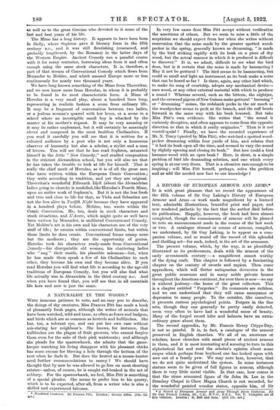A RECORD OF EUROPEAN ARMOUR AND ARMS.* IT is with
great pleasure that we record the appearance of the fifth volume of Sir Guy Laking's History of European Armour and Arms—a, work made magnificent by a learned text, admirable illustrations, beautiful print and paper, and now rendered pathetic by the fact that the author died before its publication. Happily, however, the book had been almost completed, though the connoisseurs of armour will be pleased to note an announcement made in the course of the last week or two. A catalogue resume or census of armour, compiled, we understand, by Sir Guy Laking, is to appear as a com- panion volume, and so round off the record of this splendid and thrilling art—for such, indeed, is the art of the armourer.
The present volume, which, by the way, is as plentifully illustrated as its predecessors, deals with the armour of the early seventeenth century — a magnificent sunset worthy of the dying craft. This chapter is followed by a fascinating chapter on the century of swords and rapiers. Then come appendices, which will flutter antiquarian dovecotes in the great public museums and in many noble private houses throughout the American continent, for over there is now—we say it without jealousy—the home of the great collectors. This is a chapter entitled "Forgeries." Its comments are ruthless, and we can understand that they will cause annoyance or depression to many people. To the outsider, like ourselves, it presents curious psychological points. Forgers in the fine arts, though they can generally be pretty easily detected, seem very often to have had a wonderful sense of beauty. Many of the forged sword hilts and helmets have an extra- ordinary grace about them.
The second appendix, by Mr. Francis Henry Cripps-Day, is not so painful. It is, in fact, a catalogue of the armour preserved in English churches. We all of us, amateurs or scholars, know churches with small pieces of ancient armour in them, and it is most interesting and amusing to turn to this alphabetical list and read the scholar's opinion about some casque which perhaps from boyhood one has looked upon with awe out of a family pew. We may note here, however, that we do not quite understand the system. In some instances statues seem to be given of full figures in armour, although there is very little metal visible. In that case, how comes it that the stone armoured figure of Sir John St. Los in the Strachey Chapel in Chew Magna Church is not recorded, for the wonderful painted wooden statue, opposite him, of Sir
• A Record of European Armour and Arms Through Serve Centuries. By Sir Guy Francis Inking, Bt., C.B., M.V.O., F.S.A. 'Vol. V. Complete set of Ave volumes. London; 0, Bell and Boas. [515 15s. net.] John Hauteville caparisoned in full harness ? But no doubt there is a good reason for this exclusion, for the book is too carefully edited to allow us to believe in any unconscious omission.
The book ends with a wonderfully complete bibliography and an index altogether worthy of this scholarly book.



































 Previous page
Previous page